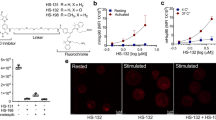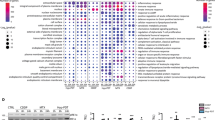Abstract
Expression of inducible heat shock protein 70 (HSP70) in tumor cells has been proposed to enhance their immunogenicity. However, HSP70 has also been demonstrated to prevent tumor cell death, a key process for the development of tumor cell immunogenicity. In the present study, we investigated the influence of the HSP70 protein level on PRO colon cancer cell growth and immunogenicity in syngeneic BDIX rats and nude mice. These cells have a basal expression of HSP70 which can be substantially increased by heat shock. When injected subcutaneously in syngeneic animals, PRO cells do not induce any detectable immune response and give rise to progressive, metastatic and lethal tumors. Stable transfection of an anti-sense hsp70 cDNA in PRO cells (PRO-70AS cells) strongly decreased HSP70 expression and sensitized cell-free extracts to cytochrome c/dATP-mediated activation of caspases. Subcutaneous injection of PRO-70AS cells induced tumors that rapidly regressed in syngeneic rats while they grew normally in nude mice. Syngeneic rats injected with PRO-70AS cells became protected against a further challenge with PRO cells. The tumor-specific immune response induced by HSP70-depleted PRO-70AS cells was associated with an increased rate of cell death in vivo. These PRO-70AS cells were also more sensitive to NO-mediated, caspase-dependent, macrophage cytotoxicity in vivo. Altogether, these results indicate that reduced level of HSP70 expression in PRO- colon cancer cells results in the generation of a specific immune response by promoting cell death in vivo.
This is a preview of subscription content, access via your institution
Access options
Subscribe to this journal
Receive 50 print issues and online access
$259.00 per year
only $5.18 per issue
Buy this article
- Purchase on Springer Link
- Instant access to full article PDF
Prices may be subject to local taxes which are calculated during checkout







Similar content being viewed by others
References
Albert ML, Sauter B, Bhardwaj N . 1998 Nature 392: 86–89
Asea A, Kraeft SK, Kurt-Jones EA, Stevenson MA, Chen LB, Finberg RW, Koo GC, Calderwood SK . 2000 Nat. Med. 6: 435–442
Beckman JS, Koppenol WH . 1996 Am. J. Physiol. 271: C1424–C1437
Beere HM, Wolf BB, Cain K, Mosser DD, Mahboubi A, Kuwana T, Tailor P, Morimoto RI, Cohen GM, Green DR . 2000 Nat. Cell Biol. 2: 469–475
Bell DA, Morrison B . 1991 Clin. Immunol. Immunopathol. 60: 13–26
Blachere NE, Li Z, Chandawarkar RY, Suto R, Jaikaria NS, Basu S, Udono H, Srivastava PK . 1997 J. Exp. Med. 186: 1315–1322
Blachere NE, Srivastava PK . 1995 Semin. Cancer Biol. 6: 349–355
Bonnotte B, Favre N, Moutet M, Fromentin A, Solary E, Martin M, Martin F . 1998 J. Immunol. 161: 1433–1438
Bonnotte B, Favre N, Moutet M, Fromentin A, Solary E, Martin M, Martin F . 2000 J. Immunol. 164: 1995–2000
Bonnotte B, Larmonier N, Favre N, Fromentin A, Moutet M, Martin M, Gurbuxani S, Solary E, Chauffert B, Martin F . 2001 J. Immunol. In press
Bruey JM, Ducasse C, Bonniaud P, Ravagnan L, Susin SA, Diaz-Latoud C, Gurbuxani S, Arrigo AP, Kroemer G, Solary E, Garrido C . 2000 Nat. Cell Biol. 2: 645–652
Caignard A, Martin MS, Michel MF, Martin F . 1985 Int. J. Cancer 36: 273–279
Caignard A, Pelletier H, Martin F . 1988 Int. J. Cancer 42: 883–886
Casciola-Rosen LA, Anhalt GJ, Rosen A . 1995 J. Exp. Med. 182: 1625–1634
Davidoff AM, Iglehart JD, Marks JR . 1992 Proc. Natl. Acad. Sci. USA 89: 3439–3442
Garrido C, Bruey JM, Fromentin A, Hammann A, Arrigo AP, Solary E . 1999 FASEB J. 13: 2061–2070
Garrido C, Fromentin A, Bonnotte B, Favre N, Moutet M, Arrigo AP, Mehlen P, Solary E . 1998 Cancer Res. 58: 5495–5499
Hibbs Jr JB, Taintor RR, Vavrin Z . 1987 Science 235: 473–476
Jaattela M . 1995 Int. J. Cancer 60: 689–693
Jaattela M . 1999 Ann. Med. 31: 261–271
Jaattela M, Wissing D . 1993 J. Exp. Med. 177: 231–236
Jaattela M, Wissing D, Kokholm K, Kallunki T, Egeblad M . 1998 EMBO J. 17: 6124–6134
Kaur J, Ralhan R . 1995 Int. J. Cancer 63: 774–779
Kaur J, Ralhan R . 2000 Int. J. Cancer 85: 15
Li CY, Lee JS, Ko YG, Kim JI, Seo JS . 2000 J. Biol. Chem. 275: 25665–25671
Matzinger P . 1998 Semin. Immunol. 10: 399–415
Melcher A, Gough M, Todryk S, Vile R . 1999 J. Mol. Med. 77: 824–833
Melcher A, Todryk S, Hardwick N, Ford M, Jacobson M, Vile RG . 1998 Nat. Med. 4: 581–587
Mosser DD, Caron AW, Bourget L, Denis-Larose C, Massie B . 1997 Mol. Cell Biol. 17: 5317–5327
Mosser DD, Caron AW, Bourget L, Meriin AB, Sherman MY, Morimoto RI, Massie B . 2000 Mol. Cell Biol. 20: 7146–7159
Negulyaev YA, Vedernikova EA, Kinev AV, Voronin AP . 1996 Biochim. Biophys. Acta. 1282: 156–162
Nylandsted J, Rohde M, Brand K, Bastholm L, Elling F, Jaattela M . 2000 Proc. Natl. Acad. Sci. USA 97: 7871–7876
Pandey P, Saleh A, Nakazawa A, Kumar S, Srinivasula SM, Kumar V, Weichselbaum R, Nalin C, Alnemri ES, Kufe D, Kharbanda S . 2000 EMBO J. 19: 4310–4322
Park HS, Lee JS, Huh SH, Seo JS, Choi EJ . 2001 EMBO J. 20: 446–456
Ralhan R, Kaur J . 1995 Clin. Cancer Res. 1: 1217–1222
Ravagnan L, Gurbuxani S, Susin SA, Maisse C, Daugas E, Zamzami N, Mak T, Jaattela M, Penninger JM, Garrido C, Kroemer G . 2001 Nat. Cell Biol. 3: 839–843
Saleh A, Srinivasula SM, Balkir L, Robbins PD, Alnemri ES . 2000 Nat. Cell Biol. 2: 476–483
Seo JS, Park YM, Kim JI, Shim EH, Kim CW, Jang JJ, Kim SH, Lee WH . 1996 Biochem. Biophys. Res. Commun. 218: 582–587
Shrestha A, Horino K, Nishiura H, Yamamoto T . 1999 Lab. Invest. 79: 1629–1642
Srivastava PK . 2000 Nat. Immunol. 1: 363–366
Srivastava PK, Menoret A, Basu S, Binder RJ, McQuade KL . 1998 Immunity 8: 657–665
Todryk S, Melcher AA, Hardwick N, Linardakis E, Bateman A, Colombo MP, Stoppacciaro A, Vile RG . 1999 J. Immunol. 163: 1398–1408
Udono H, Srivastava PK . 1993 J. Exp. Med. 178: 1391–1396
Volloch VZ, Sherman MY . 1999 Oncogene 18: 3648–3651
Wells AD, Malkovsky M . 2000 Immunol. Today 21: 129–132
Wells AD, Rai SK, Salvato MS, Band H, Malkovsky M . 1998 Int. Immunol. 10: 609–617
Xanthoudakis S, Nicholson DW . 2000 Nat. Cell Biol. 2: E163–E165
Acknowledgements
We thank M Martin and B Bonnotte for valuable advice and M Moutet for excellent technical assistance. Our group is supported by a special grant from the Ligue Nationale Contre le Cancer. Work supported by additional grants from the Comité de la Nièvre de la Ligue Nationale Contre le Cancer (C Garrido), Fondation contre la Leucémie and Poste Vert from INSERM (S Gurbuxani).
Author information
Authors and Affiliations
Corresponding author
Rights and permissions
About this article
Cite this article
Gurbuxani, S., Bruey, JM., Fromentin, A. et al. Selective depletion of inducible HSP70 enhances immunogenicity of rat colon cancer cells. Oncogene 20, 7478–7485 (2001). https://doi.org/10.1038/sj.onc.1204948
Received:
Revised:
Accepted:
Published:
Issue Date:
DOI: https://doi.org/10.1038/sj.onc.1204948
Keywords
This article is cited by
-
A novel Hsp70 inhibitor prevents cell intoxication with the actin ADP-ribosylating Clostridium perfringens iota toxin
Scientific Reports (2016)
-
A small molecule inhibitor for ATPase activity of Hsp70 and Hsc70 enhances the immune response to protein antigens
Scientific Reports (2015)
-
Targeting the testis-specific heat-shock protein 70-2 (HSP70-2) reduces cellular growth, migration, and invasion in renal cell carcinoma cells
Tumor Biology (2014)
-
HSP70 inhibition by 2-phenylethynesulfonamide induces lysosomal cathepsin D release and immunogenic cell death in primary effusion lymphoma
Cell Death & Disease (2013)
-
Heat shock proteins and heat shock factor 1 in carcinogenesis and tumor development: an update
Archives of Toxicology (2013)



